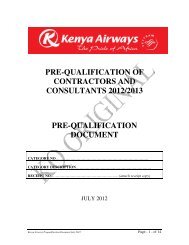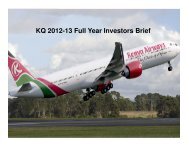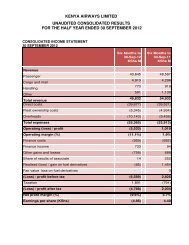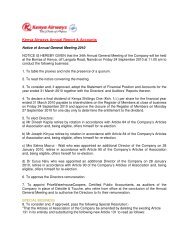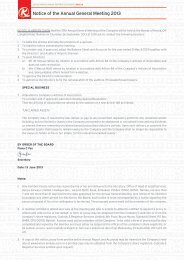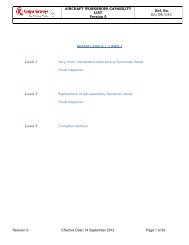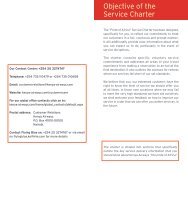Notes to the Financial Statements (cont'd) - Kenya Airways
Notes to the Financial Statements (cont'd) - Kenya Airways
Notes to the Financial Statements (cont'd) - Kenya Airways
- No tags were found...
Create successful ePaper yourself
Turn your PDF publications into a flip-book with our unique Google optimized e-Paper software.
12 <strong>Kenya</strong> <strong>Airways</strong> Annual Report & AccountsWord from <strong>the</strong> Chair (cont’d)Although it can be said that <strong>the</strong> worst is over,optimism over <strong>the</strong> recovery of <strong>the</strong> industry remainscautious. One key success fac<strong>to</strong>r will be <strong>the</strong> thriftymanagement of costs and capacity. Partnershipsand mergers within <strong>the</strong> industry are also expected<strong>to</strong> grow. At <strong>the</strong> Copenhagen Climate ChangeConference in December 2009, <strong>the</strong> IATA Direc<strong>to</strong>rGeneral unveiled IATA’s strategy for climate change.The strategy’s pillars are <strong>the</strong> green initiative, fuelefficiency improvement, logistics (shorteningroutes) and offset programs (offsets for flightsby airlines). The targets are a 25% improvementin fuel efficiency (2020 versus 2005), use of10% alternative fuels by 2017 and 50% absolutereduction in emissions by 2050.AfricaThe real GDP of sub-Saharan Africa has had aslow recovery in 2009 owing <strong>to</strong> <strong>the</strong> late onset of<strong>the</strong> financial markets recession in Africa, slightlygrowing by 2.0 % compared <strong>to</strong> a 5.9% dip in 2008.According <strong>to</strong> <strong>the</strong> International Monetary Fund’s (IMF)Regional Economic Outlook, <strong>the</strong> growth achieved in2009 is a slight improvement on <strong>the</strong> 2008 levelsinstigated by improvement in oil exporting countryeconomies and increased capital flows in<strong>to</strong> Africa.Africa’s debt position has been aggravated by<strong>the</strong> financial recession with <strong>the</strong> financial sec<strong>to</strong>rexperiencing some disturbance in asset prices.Between May 2008 and March 2009, SouthAfrica’s Johannesburg All-Share Index (JALSH)which comprises <strong>the</strong> <strong>to</strong>p tradable shares at <strong>the</strong>Johannesburg S<strong>to</strong>ck Exchange, dropped by about46%. African banks primarily felt <strong>the</strong> impact of<strong>the</strong> global financial crisis indirectly through higherfunding costs and a reduction of 2.6% in fixedinvestment in 2009.Inflation levels in 2008 s<strong>to</strong>od at 12%. In emergingand developing economies, inflation is expected<strong>to</strong> edge up <strong>to</strong> 6.25 % in 2010 as some of <strong>the</strong>seeconomies may face growing upward pressure due <strong>to</strong> morelimited economic slack and increased capital flows. Emerging anddeveloping economies are fur<strong>the</strong>r ahead on <strong>the</strong> road <strong>to</strong> recoveryled by a resurgence in Asia. In general, emerging economies havewiths<strong>to</strong>od <strong>the</strong> financial turmoil much better than expected basedon past experience, which reflects improved policy frameworks.According <strong>to</strong> <strong>the</strong> latest economic update, <strong>the</strong> IMF raised its forecastfor growth in 2010 <strong>to</strong> a 2.5% rate, which is higher than <strong>the</strong> 1.9%growth rate forecast in April. There is much less concern aboutsystemic failure in <strong>the</strong> financial system.More than halfway <strong>to</strong>wards <strong>the</strong> achievement of <strong>the</strong> 2015 MillenniumDevelopment Goals (MDGs), major advances in <strong>the</strong> fight againstpoverty and hunger have begun <strong>to</strong> slow or even reverse as a resul<strong>to</strong>f <strong>the</strong> global economic and food crises. Global unemploymentcould reach 6.1% <strong>to</strong> 7.0% for men and 6.5% <strong>to</strong> 7.4 % for women,many of whom remain trapped in insecure and often unpaid jobs.2009 has been a devastating year for <strong>the</strong> world’s hungry, markinga significant worsening of an already disappointing trend in globalfood security since 1996. The global economic slowdown, followingon <strong>the</strong> heels of <strong>the</strong> food crisis in 2006–08, has deprived anadditional 100 million people access <strong>to</strong> adequate food. Therehave been marked increases in hunger in all of <strong>the</strong> world’s majorregions, and more than one billion people are now estimated<strong>to</strong> be undernourished according <strong>to</strong> <strong>the</strong> Food and AgriculturalOrganization (FAO). Of <strong>the</strong> ten countries with <strong>the</strong> highest levelsof hunger, nine are in sub-Saharan Africa. Several countriesexperienced double digit increases in <strong>the</strong>ir main staple food pricein 2008-09. For example, cassava prices rose by 60% in <strong>the</strong>Democratic Republic of Congo (where its consumption constitutes55% of <strong>the</strong>ir calorie intake). Sorghum prices in Nigeria rose by50% from January 2009 <strong>to</strong> Oc<strong>to</strong>ber 2009.Nowhere are global public challenges more acute than in sub-Saharan Africa. With just 13% of <strong>the</strong> world’s population, <strong>the</strong> regioncarries 24% of <strong>the</strong> global burden of diseases. The global HIV/AIDSpandemic has taken its greatest impact in this region spurring <strong>the</strong>creation of global institutions – UNAIDS and <strong>the</strong> Global fund <strong>to</strong>fight AIDS, TB and Malaria. 2009 was compounded by reducedgovernment spending in <strong>the</strong> health sec<strong>to</strong>r leading <strong>to</strong> a marginalincrease in deaths. However, <strong>the</strong> number of people with HIV/AIDSgrew mainly due <strong>to</strong> a mixture of new infections and increasedusage of life prolonging medicines. Somali Pirates carried outa record number of attacks and hijackings in 2009, despite <strong>the</strong>deployment of international warships <strong>to</strong> thwart <strong>the</strong>m and a UnitedNations Security Council resolution <strong>to</strong> bring <strong>the</strong> fight against<strong>the</strong>m <strong>to</strong> shore. The Piracy Reporting Center of <strong>the</strong> InternationalMaritime Bureau said that pirates operating across <strong>the</strong> Gulf ofAden and along <strong>the</strong> coast of Somalia had attacked 214 vesselsin 2009, resulting in 47 hijackings. Twelve of <strong>the</strong>se ships, with a<strong>to</strong>tal of 263 crew members, are currently being held for ransomby <strong>the</strong> pirates. This has resulted in increased costs of shippingand insurance surcharges.Notwithstanding <strong>the</strong> above challenges <strong>the</strong> prospects for Sub-saharanAfrica’s economic growth look promising with improving politicaland macro-economic stability, huge investment opportunitiesin resources such as oil, gas and o<strong>the</strong>r minerals, commercialagriculture, transport and communications infrastructure and<strong>the</strong> renewed interest in Africa by <strong>the</strong> East, especially China. Thehis<strong>to</strong>ric hosting of <strong>the</strong> first World Cup in continental Africa inSouth Africa is expected <strong>to</strong> have a positive effect on <strong>the</strong> GDPs ofsome African countries, help accelerate <strong>the</strong> achievement of <strong>the</strong>MDGs and contribute <strong>to</strong>wards reversal of stagnated growth rates.<strong>Kenya</strong><strong>Kenya</strong>’s Real GDP per capita in 2009 grew by 2.3% <strong>to</strong> US$ 1,750.82up from US$ 1,711.63 in 2008 according <strong>to</strong> <strong>the</strong> IMF. This increaseis attributed <strong>to</strong> growth in <strong>the</strong> manufacturing, construction,agriculture, <strong>to</strong>urism, transport and communication sec<strong>to</strong>rs. Therewas notable increase of capital inflows leading <strong>to</strong> increasedprofitability in <strong>the</strong> banking sec<strong>to</strong>r. The country also benefittedfrom <strong>the</strong> Economic Stimulus Programmes and <strong>the</strong> ambitious roadinfrastructure projects across <strong>the</strong> country. According <strong>to</strong> <strong>the</strong> CentralBank of <strong>Kenya</strong> (CBK), <strong>the</strong> overall 12-month inflation maintained adownward trend throughout <strong>the</strong> year 2009. It declined from 13.3%in January 2009 <strong>to</strong> 5.3% in December 2009. The downward trendpersisted in January 2010 with <strong>the</strong> 12-month inflation dippingfur<strong>the</strong>r <strong>to</strong> reach 4.7%. The decline in 2009 through January 2010 isattributed <strong>to</strong> <strong>the</strong> falling prices of food, medical goods and services,recreation and education and personal goods and services. The



